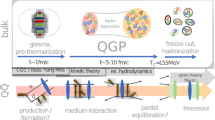Abstract
We discuss a two-component liquid model for the quark-gluon plasma. We show that the model explains the basic experimental observations of the plasma properties naturally on the qualitative level. From the standpoint of the dynamics, the model assumes the existence of an effective scalar field with a nonzero vacuum expectation value. The hypothesis that such a condensate exists is supported by lattice data. We formulate the kind of lattice data that would yield a possible verification of the model.
Similar content being viewed by others
References
E. V. Shuryak, Nucl. Phys. A, 750, 64–83 (2005); arXiv:hep-ph/0405066v1 (2004); T. Schäfer and D. Teaney, Rept. Prog. Phys., 72, 126001 (2009); arXiv:0904.3107v2 [hep-ph] (2009); D. Teaney, Prog. Part. Nucl. Phys., 62, 451–461 (2009).
S. A. Hartnoll, Class. Q. Grav., 26, 224002 (2009); arXiv:0903.3246v3 [hep-th] (2009).
M. N. Chernodub, H. Verschelde, and V. I. Zakharov, Nucl. Phys. B (Proc. Suppl.), 207–208, 325–328 (2010); arXiv:0905.2520v1 [hep-ph] (2009).
M. Luzum and P. Romatschke, Phys. Rev. C, 78, 034915 (2008); Erratum, 79, 039903 (2009); arXiv: 0804.4015v4 [nucl-th] (2008).
P. Kovtun, D. T. Son, and A. O. Starinets, Phys. Rev. Lett., 94, 111601 (2005); arXiv:hep-th/0405231v2 (2004).
C. H. Lees, Phil. Mag., 6, 128–147 (1901); L. A. Utracki, Polymer Blends Handbook, Springer, New York (2003).
S. Koh, “The onset of superfluidity in capillary flow of liquid helium 4,” arXiv:0808.4030v2 [cond-mat.supr-con] (2008).
D. T. Son, Internat. J. Mod. Phys. A., 16S1C, 1284–1286 (2001); arXiv:hep-ph/0011246v1 (2000).
J. J. Atick and E. Witten, Nucl. Phys. B, 310, 291–334 (1988); B. Sathiapalan, Phys. Rev. D, 35, 3277–3279 (1987); Ya. I. Kogan, JETP Lett., 45, 709–712 (1987).
M. Kruczenski and A. Lawrence, JHEP, 0607, 031 (2006); arXiv:hep-th/0508148v2 (2005).
A. S. Gorsky, V. I. Zakharov, and A. R. Zhitnitsky, Phys. Rev. D, 79, 106003 (2009); arXiv:0902.1842v1 [hep-ph] (2009).
M. N. Chernodub, A. Nakamura, and V. I. Zakharov, “Deconfinement phase transition in mirror of symmetries,” arXiv:0904.0946v1 [hep-ph] (2009).
C. P. Herzog and A. Yarom, Phys. Rev. D, 80, 106002 (2009); arXiv:0906.4810v1 [hep-th] (2009).
Author information
Authors and Affiliations
Corresponding author
Additional information
Prepared from an English manuscript submitted by the authors; for the Russian version, see Teoreticheskaya i Matematicheskaya Fizika, Vol. 170, No. 2, pp. 258–264, February, 2012.
Rights and permissions
About this article
Cite this article
Chernodub, M.N., Verschelde, H. & Zakharov, V.I. Two-component liquid model for the quark-gluon plasma. Theor Math Phys 170, 211–216 (2012). https://doi.org/10.1007/s11232-012-0023-8
Published:
Issue Date:
DOI: https://doi.org/10.1007/s11232-012-0023-8



